Working Oak
I’ve been ploughing grooves for my latest project in European oak. Oak always works really well with hand tools, that’s why I love it, and if you know the tricks (which I always pass on when I remember to), even the wildest grain will yield up crisp and clean results when you know what to do. Plane it, scrape it chop and pare-cut this wood and you’ll find it to be one of the easiest and most pleasing woods in the world to get good results from no matter which hand tools you’re using in the moment. In my early days living and working in the USA, it seemed that everything was made from either oak or maple and that products made from it seemed ALWAYS to end up stained. In those early days I could pick up curlier maple and oak with distinctive grain for half the price of straight-grained and boring woods because these woods would pop out of the plain-grained woods too much and the merchants found it harder to sell it. The thing about oak is that if the grain changes are not so prominent they become too distracting—the word complimentary springs to mind. Most oak pieces will complement one another and can run side by side until you get to medullary rays and then you have to really take care to choose your pieces because now you have personality issues.
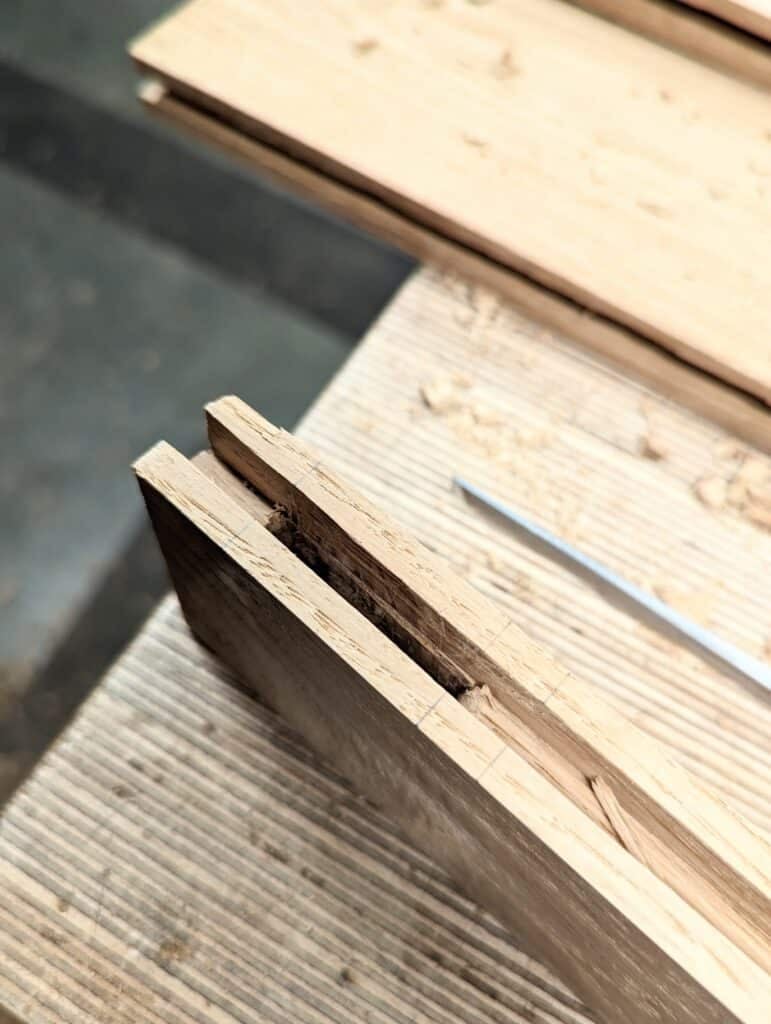
We know oak best for its intrinsic strength, resilience and reliability under all kinds of pressures. Split along the grain and create continuous grain in your parts and oak stands supreme amongst the best. It’s a coarse-grained, open-pored wood and the grain can be quite diverse. The importance of sharp planes cannot be over emphasised. Awkward grain is not a question of changing out planes, cutting irons and bed angles between bevel up and bevelk down planes. That is way to time consuming resulting mostly in torn grain, Reach for a well sharpened and set #80 and this tool alone will tame the wildest grain immediately. If you have made a mistake and already taken that poorer choice and tried with the plane the #80 will get ypou back on track.
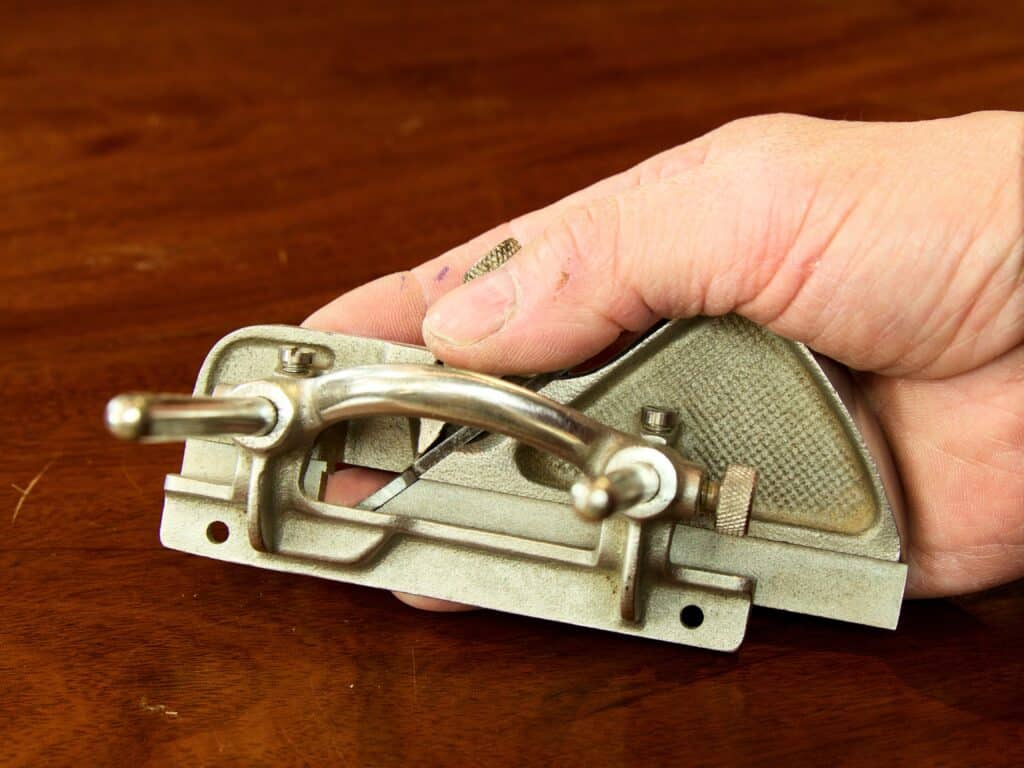
Back in the 1970s and on up for a decade or two woodworkers looked at exotic hardwoods to use them in part or for the whole of a particular part of their design. Thankfully, we have cut back dramatically on that, limiting their use for contrast features rather than a whole piece. Trust was that a whole piece in an exotic wood often looked more gawdy than attracive. Had the mahogany forests been well managed there would still be plenty of a sustainable resource for us to make from. But the depletion of rain forests was less about usable wood than creating land to raise cattle on to feed the meat-eating planet. Often, wood as in rough, site-sawn timber in the forest was used more as balast for the return voyages rather than need, but of course profiteers are profiteers no matter which flag you fly. Deforestation was always rooted in pure greed rather than real need.
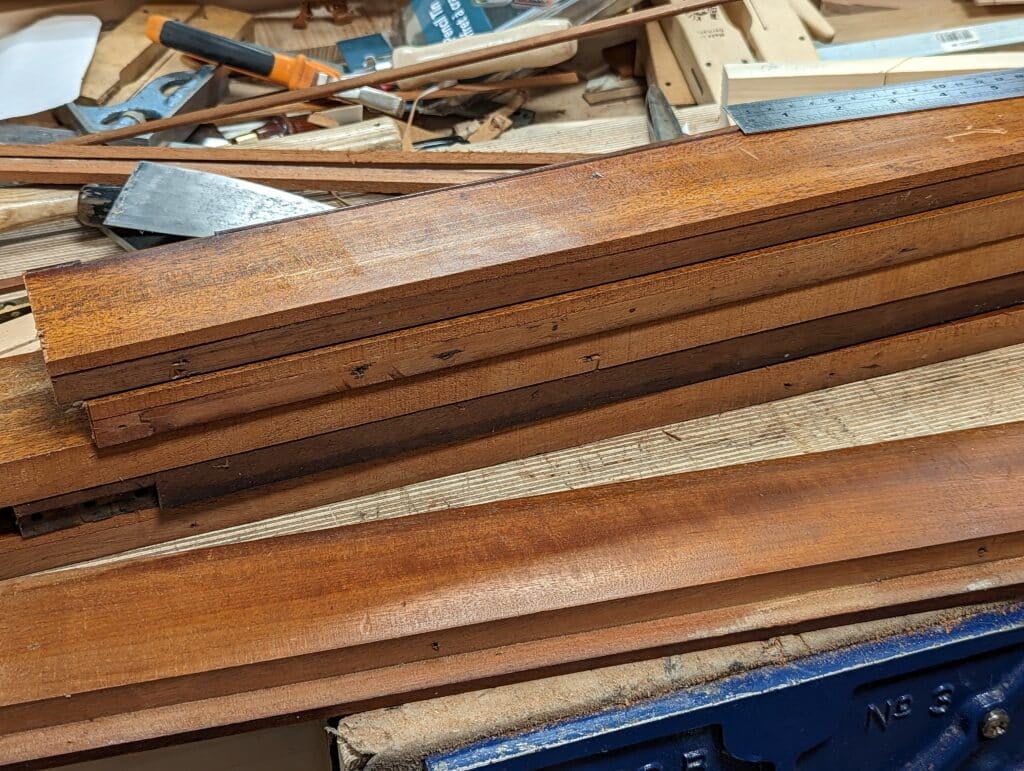
At least that’s what we have worked out. I think it’s always a combination of all things greed that creates the imbalances we are having to deal with now. The Industrial Revolution has now become the new frontier of the technoindustrial revolution and it all needs paying for somehow. The whole of the Eastern Seaboard of the USA was at one time wholy covered with Pinus Palustris. The common name of Long-leaf Pine in the 1800s and a century and a half later was reduced to a mere 35,000 acres. Funny isn’t it, in the 1980s they predicted that the computer would eliminate the need and therefore use of paper and a decade later the computer stands responsible for our using four-times more than those decade before. Typos became too easy to replace with another 500 copies and the first 500 trashed into our newly emerging recycling endeavours.
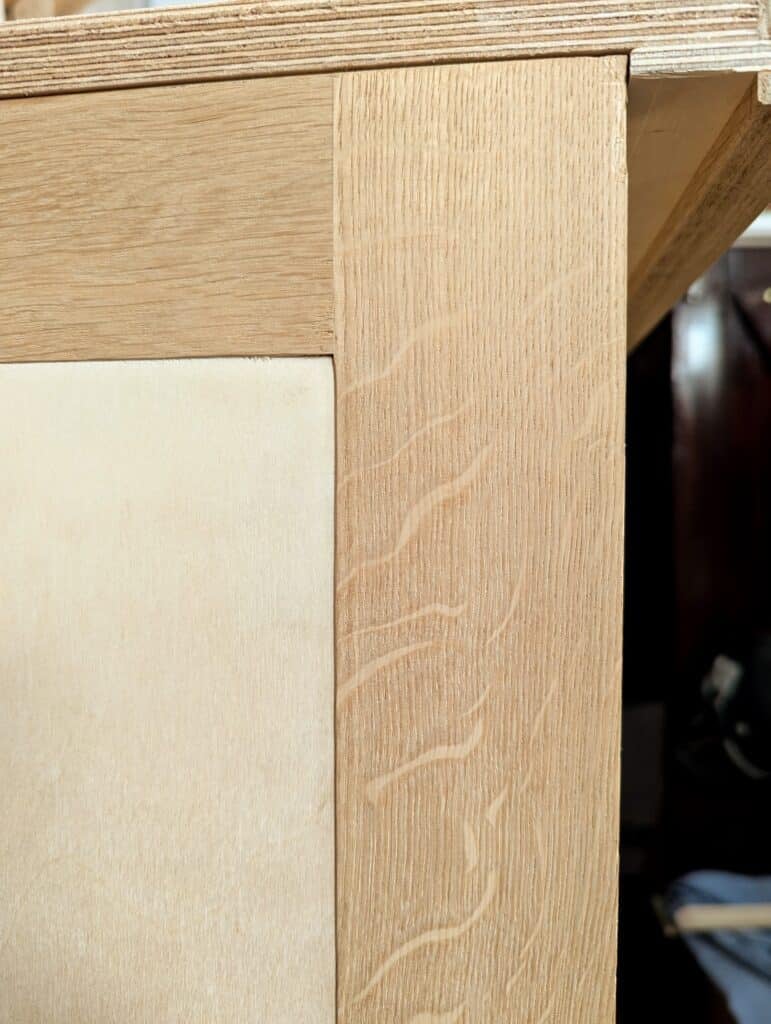
I’m working between solid oak and quality birch plywood on a couple of upcoming projects. Plywood is one of our more remarkable inventions for engineered wood in sheet form. We designed these materials to create economic panel-boards of wood but then too a material with omni-directional strengths to do things we cannot do with solid wood. If the quality is striven for, it yields an almost shrink-proof panel to almost any size you might need and you can buy it up to two inches thick from the right maker or you can laminate sheets together to get the added thickness you might want. My first plywood benches were an experiment and I have no regrets at all in making mine and using the one I have used every day for the past recent years. I went for top-quality plywood in birch for the thick outer veneers because I didn’t need anything decorative. I enjoyed bringing this bench to pass and made a second one identically with no changes. It’s holding up better than fine. It will outlast me.
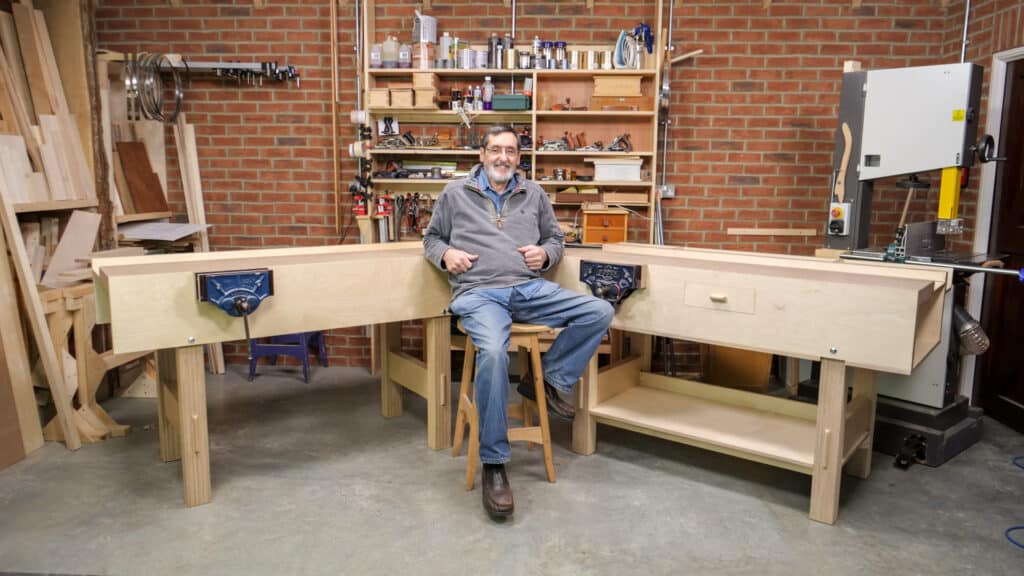
Often times it is less what we do with remarkable inventions than what we do to them or end up doing with them. Back in the 1990s we had a great quick-release (QR) vise made by Record for a century before then. Copies started to be made in China, Taiwan and India and sellers like Woodcraft, Rockler stocked the cheap imports which looked the same and had the same action but were not one and the same as Record of old. They then controlled the buying price for a season and sold them for half the price of Record. Of course, Irwin Record couldn’t compete and soon dropped the line altogether. Such is the way of global competition––a demoralising reality. It’s actually hard to find a good vise any more but they are out there if you can pick your way through the and then what we end up doing with them‘experts’ started to be working in marketing and sales who are sales personnel and rarely experienced woodworkers. I just watched the uncomplicated installation of a bench vise made complicated by the installer . . .


Since the Record vises are hard to come by and many of us do have the chinese copies, why the difference? I have been trying to solve the sloppiness issue in the vise for a time now. I think the main culprit to be the stabilizer at the end of the steel rods and threaded rod. Has anyone come up with a way to correct the slop? I’m sure the answer is simple yet elegant, but I haven’t found it yet. I know this isn’t woodworking per se, but it does greatly affect woodworking.
I have a “Record” branded 12″ vice from about 20 years ago. Just about the time the production shifted I think. So while it is a “Record” vice it isn’t a “RECORD” vice if you get the drift.
To deal with the little bit of slop (perhaps it is greater now in newer units) where the rods pass through, I found some thin shim stock and simply cut four strips, slipped them in so that they take up the space from bottom and folded them to keep them in place. Bought the brass as a hobby pack from a local hobby shop so YMMV. For lubrication I wax (paraffin, not beeswax – find that to be sticky) but last time I had some fancy dry-lube spray used elsewhere and that also works. I haven’t inspected the brass lately but since it is softer than the steel, eventually I’ll need to replace it.
I may just be lucky and the half-nut cinches up tight so all I do is keep the teeth clean and a bit of wax/dry lube once in a while.
Side note, I’ve found that, at least in my area of the USA, people are putting lots of metal working and woodworking equipment up for sale in the Facebook “Marketplace”. Caveat emptor of course but found a few good deals on 2nd hand Starret which I’ve snapped up. And seen several vices go by that may just need some TLC at very reasonable prices. Wouldn’t ship them, just perhaps lucky in that my area they are showing up. FB Marketplace has no fees in many cases and seems to be more popular than Ebay lately.
There is no doubt that earlier versions of Record, the pre Irwin-days versions, are vastly superior. Buying old ones via secondhand sites has always worked well for me. Currently, I am considering selling off haf a dozen of my school benches which all have Record or similar fitted. I am on my second Woden 189B No3. Best vises I ever owned but that’s just me.
I’ve not tried this, but one might be able to have the outboard castings, through which the two steel rods run, bored out and metal bushings inserted, to correct size if available. If not, some honing would be necessary.
Paul, unrelated to this post. I follow what I believe is your page on Facebook. An interaction this morning had me doubting it was really you.
Can you clarify please?
It was regarding a post about using plywood with oak..
I am using top-grade birch plywood on my project. I have done this before because it is an amazing invention and it resolves so many issues for thos strapped for time, skill levels, money and so much more. the concpts of joinery i have pulled together are unique so I dId what I do as I always do with the best interests of my whole audience in mind around the world and rarely for public approval and certainly never for professional woodworkers who are my strongest criticcs because they are, well, mostly thoroughly judgemental. Just sayin’ it the way it is.
I am using a plywood workbench that I built 39 years ago, and the top is still flat. I have added/improved it over the years but the flat laminated birch ply top is 2 1/4″ thick, and it absolutely does not wiggle. The only thing I wish is that the top was 3 3/8″ thick sometimes. But if I chop my mortises near the leg it doesn’t bounce. I have thought many times about building a new bench, but I don’t think I could improve on this bench much and I have worked on it for so long I don’t want to say goodbye. My only beef with good plywood is finding it and then being able to afford it.
Paul, I watched an interesting documentary on the late, great J.R.R. Tolkien last night, Linguist, Oxford Don and author of The Hobbit and Lord of the Rings. His eldest son Christopher said he liked traditional things and disliked “modern” by which he apparently meant “machines”. I was reminded of somebody! 😀
Futhermore, he went onto to say that “the ring” (evil and powerful), in the above books, was (or re-presented) a machine in his way of thinking.
So you (/we) are in good company 🙂
Ply gives you eye-catching stripy dovetails too.
This is timely because I’m in the middle of making a small ship’s bookcase from oak. I’m finding the stuff a bit of a challenge to be honest. I can seldom afford high quality timber but on this occasion I have been given three short boards of American White Oak (Quercus Alba?) that were on their way to the kindling bin so I thought of what can I get out of this? I don’t like the idea of wood going to waste.
It seems to me more demanding of the sharp tools and I’ve had to do a lot more stropping than usual! I’ve found it difficult to achieve a clean, square bottom in dado housings even with the router plane and have a lot of trimming to do with chisels. But I’m learning and getting there!
(A ship’s bookcase by the way is one with removeable battens across the shelves to stop books flying out when you whack a big wave).
Funnily though, I made a quick table trivet for Mrs H from the offcuts. Simple half lap joints cut very tight and pinned with oak dowels so no glue needed to get degraded by hot pans. Her friend saw it and asked me to make twenty or so to sell in her craft shop. So the thing I made to use up scrap is more popular than the really nice piece I’m trying to complete.
Hey-ho.
By the way, regarding the previous comment about FB marketplace, I’ve found it a good source of old and damaged furniture which can yield some nice pieces of beautiful timber, often a hundred or more years old which is a joy to work. Especially Victorian wardrobes. Nobody wants them anymore because modern houses don’t have space for them but the wood is often gorgeous.
I have a Wilton 10-inch woodworkers bench vise that I have come to like a great deal. It doesn’t have the guide rods on the sides and is less prone to wracking than my old copy of a Record was. It has a heavy, square sectioned housing for the screw, that keeps the screw more free of debris, and acts to stabilize the face laterally. Because there are no guide rods, the work can positioned close to the center of the vise when working on ends.
Hello Paul,
I have purchased on old record 52D, took everything apart to clean it. Now it is having an issue with the quick release. Whenever I want to tighten a piece in the vice, it snaps. I can’t find the cause or solution. I tightened the spring, but that doesn’t help.
Any thoughts?
Luc
I use snap to mean break, I don’t believe you mean that, so I am guessing that the thread is jumping. When you installed it, is anything catching so that the half nut can’t seat fully?
Sounds like there is enough force in the spring to hold the half nut in place. You can start a notch or two further back on the castled nut, or buy a new spring and nut on ebay.
*isn’t
I have to admit, you made me look up the word, “immoveablke”
Love your work and mission.
Happiness is the byproduct of people doing something they feel is truly worthwhile.
Is that why we’re happy?
Paul, so you’d opt for a Stanley-style 80 cabinet scraper to deal with awkward/troublesome grain, at least with oak, rather than, say, a temporary poor-man’s York-pitch tweak to your plane iron? Good to know, I like my NOS Stanley 80 🙂 .
Long Leaf Pine only ever grew from North Carolina south, not the whole of the eastern seaboard of the US.
My luthier of many years died and left me some of his tools. Some of his planes are sharpened in ways I dont really understand. Bevels on both sides the cutting iron. I think this is to effectively decrease the cutting angle. Did he sharpen his irons this way to accommodate uneven wood grain? I wish I could ask him.
Ray
On a bevel down plane, you can add a bevel on the back of the iron (which then will face upwards) in order to _increase_ the angle of the cutting iron, without needing a different frog or a different plane. This can be beneficial for difficult woods and/or highly figured woods.
On a bevel up plane, it would not make any sense to do this, except MAYBE to reinforce the cutting edge by having more “meat” behind it – but that would mean an extremely low angle on the cutting iron.
Usually, a bevel up plane is praised because you can have different cutting angles by swapping irons or re-grinding the one you have. For the most part, I think this is more of a “sell more planes and parts” argument than an actual argument. A cabinet scraper or a card scraper is MUCH cheaper, and works extremely well. And of course, you can just grind a back bevel on a spare iron. They are not very expensive..
Thanks Paul. I love my plough almost as much as I love a router hand plane. I ended up getting the Veritas one 8 years ago and now own a bunch of blades.
Rather recently, I have an opportunity to purchase a new wooden “plough plane.” I put in quotes because it probably doesn’t meet the proper definition of a plough plane. it is designed to do just one thing, it produces a quarter inch wide quarter inch groove one quarter inch up from the edge that is a quarter inch deep. All fixed. I think it could be very useful for making grooves in the bottom of drawers. No varriability but for drawer bottoms that might be just fine for 90% of them. Was curious enough to buy it and see how it works out. Certainly wouldn’t want this to be my only plough plane but might be fun to play with.
I have learned the hard way that great tools, be it a vise or a chisel or plane, have high prices for a reason. Being a hobby woodworker I obviously wanted to start cheap so I bought the 30$ hand plane and some chisel set for less than 20$. They were ok and with these i grew more experienced in sharpening; then I found a 8$ hand plane made in India and the curiosity struck me: “how on earth could a 8$ plane give the same outcome as the 30$ ?”
I got my answer shortly after: “it just cannot”. A VERY cheap tool had obviously been produced with some lower quality materials and lower quality control. The frog was not plane, it did not sit well on the sole of the plane, the handles were from cheap plastic which broke in splinters, the adjuster lever was just a thin bendable metal sheet, and the plane iron was chipped, warped and extremely hardened so it seemed almost impossible to sharpen it on a cheap water stone (this, however, made me buy a diamond stone). In the end, the plane was just used as an exercise to ‘set up a new hand plane’.
The conclusion is that: if you buy an extra-cheap tool, the money you don’t spend on something more expensive you end up losing over time. Just consider the enormous amount of time required to set, fix, repair and sharpen a cheap product, and also the physical energy that you have to spend and the frustration that accumulates since you fight to make a 5$ plane usable instead of doing something with it on the wood, all this while your hours available for hobby-woodworking could be in a very limited amount over the course of a month.
I doubt that we are talking apples for apples here, really. A good tool for me, no, an excellent tool for me, has been the #4, and one or two other Stanley versions and there is a difference in terms. You use the term cheap and people often do that to demean something. Many refer to Stanleys as cheap planes but they are not cheap in the sense of being poorly made or from poor materials. They are really just inexpensive tools for working people when times were hard. As for all planes made in India being cheap, I doubt that that is true either but it can be demeaning depending on how its expressed.
Hi Tudor,
I understand your point but gotta say my experience has been different.
Paul uses his words precisely as usual, cheap is not the same as inexpensive.
I am proud (hubris?) that ALL my tools were monetarily inexpensive, as I only buy what others consider useless or “junk”. They do usually look like a chunk of rusty metal with bits of wood stuck here/there.
My old record #52 was seized and accompanied by a “twin” Woden of same age and shape which works solidly, but is completely missing its back jaw – I’ve disassembled and cleaned the first (it’s perfect now), and the second I have installed using the bench top as the missing jaw.
There are worthless tools, indeed. I’ve seen them old and (mostly) new, even “Made in Sheffield”.
Because repairing is something that gives me great pleasure (He kai kei aku ringa), I often feel that my tools come out FREE, despite the low cash initially spent. The real value comes out of using them – I’m sometimes a caretaker, but I’m no collector.
Best regards,
Paulo
Worth adding: these vices I’ve got from someone who held on to these from his late woodworker father. The record for the price of three pints, the Woden free. I offered him to pay nothing, refurbish both and he could keep the Record, he refused. In memory of his father I sent him photos of them refurbished, he said he wished he could work any wood …but declined my offers to help starting. Oh, well.